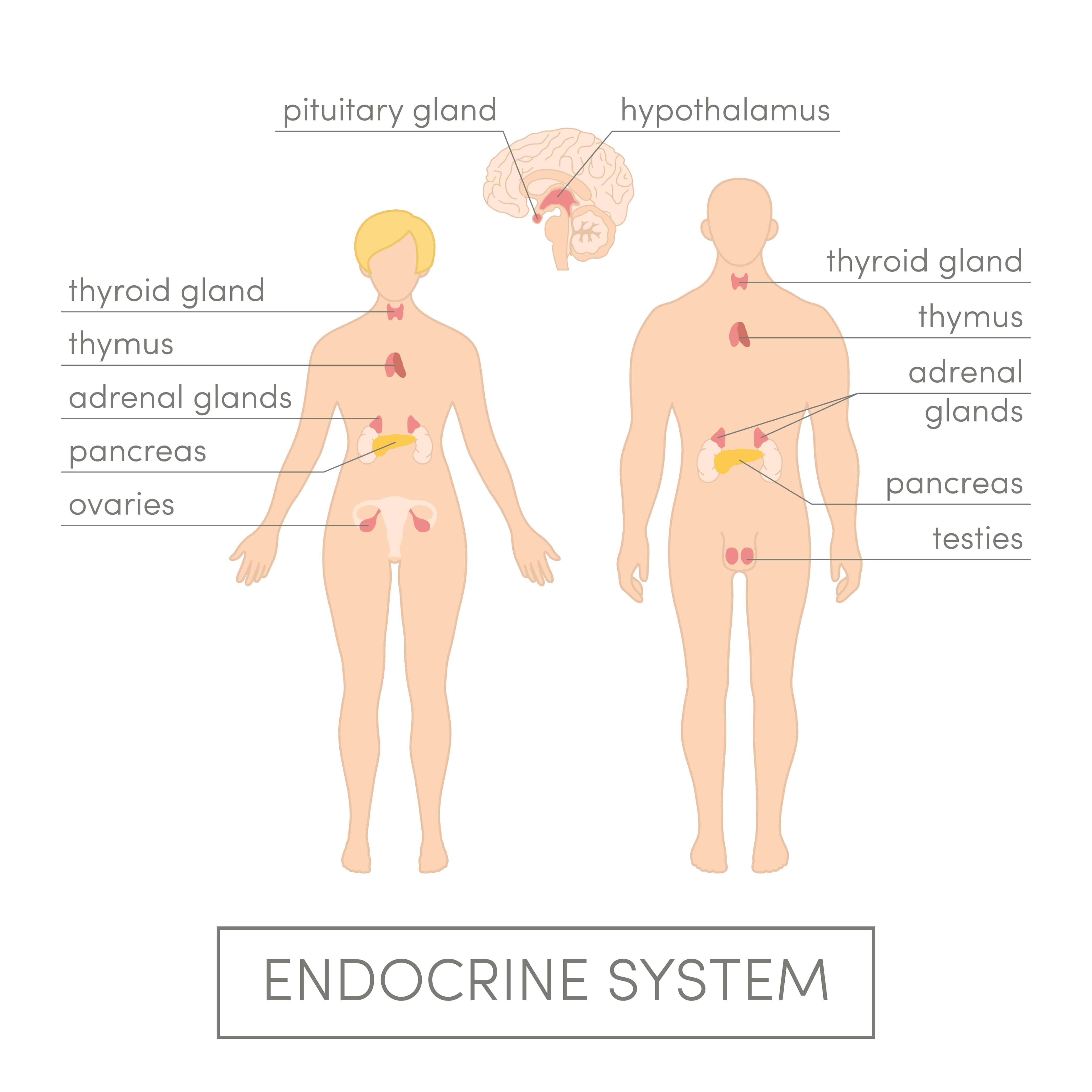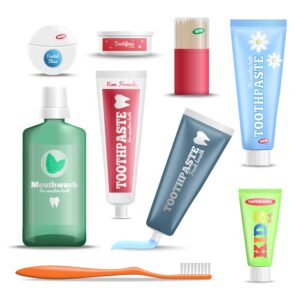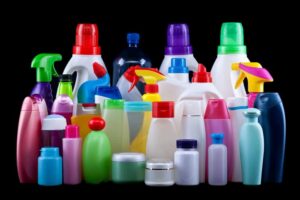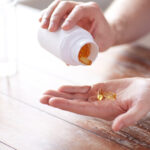Endocrine Disruptors: 14 Common Chemicals That Affect Your Hormones

Hormones. They’re often the butt of the joke when it comes to pregnancy, PMS, or teenagers. Other than that, we mostly just ignore our hormones.
But did you know that just about everything you do is dependent on subtle changes in your hormone levels?1
That’s right: How much energy you have during the day, how well you sleep at night, whether you’re interested in sex. How much you struggle with your weight, whether or not you can digest your food properly, and how easily you can fight off illness— that’s all hormones.
In this article, we’ll be taking a close look at how the endocrine system (our hormone-making and monitoring system) works, as well as 14 of the most pervasive, dangerous endocrine disruptors we’re exposed to on a daily basis in modern society.
You might have heard these chemicals called “the dirty dozen.” And while “the dirty dozen” certainly has a nice alliterative ring to it, the two chemicals we’ll be adding to the list are every bit as dirty--and every bit as devastating — to your endocrine system.
What Are Endocrine Disruptors?
Endocrine disruptors2 are chemicals (either human-made or manufactured) that disrupt or damage your body’s hormone-making organs or processes. This can happen when a chemical mimics a particular hormone, keeps your body from using or absorbing a particular hormone, interferes with the way your hormones talk to each other, or hijacks your hormone-producing organs.
Why does that matter so much? And what’s the worst that could happen from a little hormone disruption? The truth is, most of us are woefully miseducated when it comes to understanding how our endocrine system works, the role hormones play in our bodies, and the harm we can suffer if our endocrine is compromised2--including reproductive damage, thyroid disease, neurological harm, immune dysfunction, and birth defects.
How Does the Endocrine System Work?

Your endocrine system is a complex network of organs and glands that work together to create, distribute, and regulate the hormones your body needs to function properly.
Your endocrine system is a complex network of organs and glands that work together to create, distribute, and regulate the hormones your body needs to function properly.
The head honcho of your endocrine system is a part of your brain called the hypothalamus. It calls the shots on just how much (and when) different glands in your endocrine system release hormones into your bloodstream so they can get to work regulating your metabolism, cell growth and repair, sleep cycles, stress levels, and sexual function.
Another part of your brain, called the pituitary gland, relays messages between the hypothalamus (the boss) and your hormone-producing glands.
Whether you’re male or female, your endocrine system includes your hypothalamus, pituitary gland, pineal gland (another part of the brain), thyroid, parathyroid, adrenal glands, and pancreas.
Your gut and your liver aren’t usually grouped in with your endocrine system, but for all intents and purposes, they should be, since they produce a significant portion of the hormones your body uses on any given day. (More on that below!)
If you’re a woman, your endocrine system also includes your ovaries. If you’re a man, it includes your testes.
Endocrine System Organs and Hormones
If you want to know what people mean when they say that the human body is a marvel of engineering, just take a look at the endocrine system organs and hormones. When they aren’t bogged down by chemical disruptors (which we will discuss), your endocrine organs and hormones work together seamlessly in an intricate, fascinating dance every moment you’re alive:
Hypothalamus
Like I said above, the hypothalamus is located in your brain and calls the shots (based on information it gets from your pituitary gland) on when and how much hormone your other glands create.
The hypothalamus also regulates your body temperature and your metabolism. It’s the reason you get a fever when you’re sick, to weaken the invading virus or bacteria.
Pituitary Gland
This endocrine organ is located in the brain and stores important hormones (and distributes them as needed). It also runs traffic control with the other glands in your body, relaying signals back and forth between your hypothalamus and making sure everything is running properly.
Your pituitary gland creates and regulates all of the following hormones:
- TSH (Thyroid-stimulating hormone): This hormone prompts your thyroid gland to kick into gear and produce its own hormones.
- Growth hormones: These hormones are critical to growth and development, as well as maintaining a healthy overall body composition of bone, fat, and muscle.
- Follicle-Stimulating Hormones and Luteinizing Hormones: These hormones regulate the levels of sex hormones (estrogen, testosterone, progesterone, steroids) your body produces.
- Prolactin: This is the hormone that triggers the body to produce breast milk in women!
- Adrenocorticotropic Hormone (ACTH): ACTH triggers the adrenal glands to produce cortisol and other steroids that metabolize food, control blood pressure, and lower inflammation.
- Vasopressin (antidiuretic hormones): These hormones help your kidneys manage water loss.
- Oxytocin: Also called “the bonding hormone,” oxytocin helps regulate your emotional health and reduce stress. It also causes uterine contractions during childbirth.
Thyroid Gland
Your thyroid, which is located at the front of your neck, is in charge of creating thyroid hormones. These thyroid hormones are absolutely vital to metabolism and digestion,3 as well as a whole host of other body functions including your muscle tone, how well your reproductive system works, nervous system and brain development in children, and how effectively your body can control its blood pressure and heart rate.
Parathyroid Gland
You have two parathyroid gland, that sit right next to your thyroid. Their biggest job is to create something called parathyroid hormone, which controls how much calcium is funneled to your bones and bloodstream.
Pineal Gland
Located deep in the brain between the left and right hemispheres, this tiny gland has one big job: producing melatonin, which controls your sleep/wake cycles. When you wake up, when you fall asleep, and how well you sleep all hinge on melatonin produced in the right amounts, at the right time.
Adrenal Glands
Your adrenal glands are in charge of creating hormones called corticosteroids. Every time you feel your heart rate rise or drop, that’s your adrenal glands. These tiny but mighty glands live right above your kidneys, and they regulate your metabolism, how your immune system functions, how well you deal with being stressed and how quickly you recover from stress, and even your sexual function.
Pancreas
Your pancreas is tucked just behind your stomach. It’s in charge of creating digestive enzymes and controlling your blood sugar by producing the hormones glucagon and insulin, which break down carbohydrates and sugar.
Ovaries
In women, the ovaries are the main source of sex hormones including estrogen and progesterone. These hormones are critical to sexual development, sexual health, and sexual function (including arousal, menstruation, and fertility.)
Testes
In men, the sex hormones are mostly made in the testes, which produce androgens like testosterone. Testosterone is the biggest factor in onset of puberty, sexual development, how much facial hair you grow, your sex drive, and your sexual health.
Gut
Until recently, the gut was pretty much ignored when it came to hormone production. But, to many people’s great surprise, the gut is actually extremely important to hormone production.
The bacteria in your gut (and the short-chain fatty acids they help create) are responsible for 95% of your serotonin and 50% of your dopamine4 not to mention some melatonin and adrenaline.
Your gut health, then, is directly linked to your mood, your sleep cycle, your appetite, and your ability to stay alert, among other important functions.
Liver
The liver is another unsung hero of the endocrine system. This organ creates bile to break down excess hormones to regulate hormone levels. It also produces some of your estrogen and testosterone.
Risks and Results of Endocrine Disruption
Think of endocrine-disruptors as identity thieves--chemicals that can flip the same switches as your body’s own hormones5--but can’t be regulated or reabsorbed in the same way.
And these identity thieves can cause a lot of problems. (More on the specific problems different endocrine disruptors cause below!)
Endocrine disruption in the adrenal and thyroid glands can mean weight gain and problems managing blood sugar,6 difficulty controlling sleep/wake cycles, and thyroid disease.7 Disruption of the sex hormones like testosterone and estrogen can lead to infertility, sexual dysfunction and cancers, and early menopause.
Endocrine disruption can also trigger autoimmune diseases8 as the body struggles to separate friend from foe, and cancer as these chemicals alter cell growth and destabilize DNA.9
Each of the following 14 endocrine disruptors destabilizes and hijacks the endocrine system in different ways. Knowing the names of these chemicals, where you are exposed to them, why they’re so harmful, and how you can avoid them is absolutely critical your health:
14 Common Endocrine Disruptors
Some of these endocrine disruptors may be familiar to you — lead, for instance. Others may have names you don’t recognize at first. But take a closer look at the back of a shampoo bottle, or the lid of your cup of coffee, or the ingredients in your “pet-friendly” lawn fertilizer. Here’s what you need to know:
1. BPA
What is BPA, and Why Is It Harmful?
BPA is a chemical that mimics estrogen. Which might not sound like such a bad thing, at first. After all, don’t a lot of women benefit from hormone replacement therapy?
Unfortunately, this imposter-estrogen derived from plastic (aka, not even remotely biocompatible with our endocrine system) spells disaster. BPA’s fake plastic estrogen can cause breast cancer, prostate cancer, infertility, heart disease, weight gain, and a whole host of reproductive issues.10
Where Is BPA Found?

- Sports water bottles
- Baby pacifiers and toys
- Many foreign-made trinkets and toys
- In the lining of metal canned food containers (just another reason to eat fresh, raw foods!)
- The coating on the receipts you get at the grocery store.
- #7 recycled plastics
- Most plastics labeled “polycarbonate.”
How to Avoid BPA
Get ready to feel queasy: One study showed that 93 percent of us have BPA in our bodies. Right now. Only use plastics that are specifically labeled “BPA free,” and be safe instead of sorry by doing your research and assuming the worst if “BPA free” isn’t specifically noted.
Opt for plastics with a 1, 2, or 5 label, if you must use plastic, and use glass instead of plastic whenever you can.
You’ll also want to keep an eye out for BPS or bisphenol S. BPS is nearly identical to BPA, but manufacturers sometimes use it to skirt around BPA laws, despite the fact that it’s been proven to have similar health effects. BPA has gotten the most press, but I believe you will be learning over time that all plastics are problematic.
2. Perchlorate
What Is Perchlorate, and Why Is It Harmful?
Perchlorate is a chemical combination of chlorine and oxygen that’s found, among other things, in fireworks and rocket fuel.
Some types of perchlorate are man-made, while others occur in nature. Perchlorate has the unique ability to rob your thyroid of iodine11--a basic requirement for your thyroid to produce hormones and function properly.
Perchlorate can wreak havoc on your metabolism, your brain function, and how well your internal organs function.
Where Is Perchlorate Found?
Perchlorate has infiltrated the drinking water supply in many areas of the United States because of emissions during military operations, manufacturing, and crop fertilization. It’s also present in varying quantities in some foods, most of them highly processed:
- Boxed mac and cheese
- Salami
- Bologna
- Plain bagels
However, even some fresh, raw produce like broccoli, collard greens, and cauliflower may test at high perchlorate levels.
How to Avoid Perchlorate
Educate yourself to find out whether you’re at special risk for perchlorate by finding out whether you’re near any types of manufacturing plants or facilities that use perchlorate. If you are, there’s a high likelihood that this water-soluble compound has infiltrated your water supply.
A reverse osmosis system (paired with a water remineralizer and ionizer) can filter out perchlorate in your water. As for perchlorate for fresh produce, it’s much more difficult to avoid, and a good argument for buying organic produce. However, you can combat the small quantities of perchlorate you may ingest and help your thyroid work properly by making sure you get enough iodide in your diet (use nascent iodide,12 not chemically treated iodized salt!)
3. Dioxins
What Are Dioxins, and Why Are They Harmful?
Dioxins are a class of toxic chemicals that are created from burning fuel or waste, producing pesticides, and other chemical processes in manufacturing. Once dioxins have been released into the air, they quickly settle in the soil, where they make their way into the water supply and plant life.
One of the (many) reasons dioxins are so harmful is that, once consumed, they stay in the body for many years, building up and causing damage to tissues and systems. Dioxins can cause cancer, diabetes, and cellular mutations; wreak havoc on the human immune system; cause learning disabilities and delays; disrupt sex hormone signals; and damage reproductive processes,13 including permanently decreasing sperm quality and count.14
Where Are Dioxins Found?
Make their way up the food chain when animals drink water or eat food that is contaminated with dioxins. Those dioxins are then tucked away and build up in the animals’ fatty tissues. Experts estimate that an incredible 90% of the dioxins humans consume come from the following animal products:
- Beef
- Dairy
- Milk
- Chicken
- Pork
- Fish
- Eggs
How to Avoid Dioxins
Since most of the dioxins we’re exposed to as humans come from the animal products we eat, the very best way to avoid dioxins is to eliminate as many animal products from your diet as possible. Just another reason that a raw, plant-based diet is so important to our health!
If you do choose to eat meat, choose lean protein and cut off any visible fat. Another extremely important way to avoid dioxins is eliminating backyard burning of wastes. The EPA says, "Backyard burning of waste materials creates higher levels of dioxins than industrial incinerators and is particularly dangerous because it releases pollutants at the ground level where they are more readily inhaled or incorporated into the food chain."
4. Atrazine
What Is Atrazine, and Why Is It Harmful?
Atrazine is a type of herbicide that’s used on numerous crops including corn and sugarcane to stop broadleaf weeds. When women are exposed to Atrazine during pregnancy, their children run a higher risk of birth defects including heart, urinary, and limb deformation.15 Atrazine also mimics estrogen and disrupts hormone production16 in the ovaries and testicles, delaying puberty, and causing breast and prostate cancer.
One study17 showed that atrazine exposure effectively sterilized 75% of male frogs, and turned one out of 10 into females capable of producing viable eggs.
Where Is Atrazine Found?

- Corn
- Sugar Cane
- Winter wheat
- Sorghum
- Lawn turf
How to Avoid Atrazine
To avoid consuming atrazine that has made its way into your drinking water, use a really excellent water filtration system. You can also keep atrazine out of your life by avoiding pesticides on your lawn (many of which contain atrazine) and buying organic (non-sprayed) produce at the store whenever possible.
5. Phthalates
What Are Phthalates, and Why Are They Harmful?
Phthalates are a family of chemicals used to create solvents and soft plastics. You’ll find this endocrine disruptor in everything from makeup to plastic wrap to medical tubing. Phthalates cause damage to the kidneys, liver, lungs, and the reproductive system. The most common phthalates found in consumer goods are dibutylphthlalate (DBP), dimethylphthalate (DMP) and diethylphthalate (DEP).
Phthalates disrupt the endocrine system and wreak havoc in the human body by acting as an “anti-androgen,” which blocks testosterone from working normally (testosterone is important for both men and women!). This disruption can lead to abnormal fetus development,18 the birth defect hypospadias,19 premature puberty in girls,20 and insulin resistance.21
Where Are Phthalates Found?
Phthalates are everywhere. Any time you read the word “fragrance,” assume that this harmful chemical is present.
(Under the EPA regulations, companies aren’t required to disclose the presence of phthalates in “fragrance”). And while many industrialized nations are taking steps to reduce phthalate exposure--especially in hospitals (some of the highest levels of phthalates have been found in NICUs!22), you should know that phthalates may be lurking in all of the following places:
Plastic wrap and other plastic food packaging
- Medical tubing and IV bags
- Laundry detergent (hidden under the generic catchall “fragrance”)
- Candles
- Hair spray
- Nail polish
- Aftershave
- Lotion, shampoo, and other personal care products (A study conducted by Health Care Without Harm report found phthalates in a horrifying 70% of cosmetic and personal care items23).
- Vinyl shower curtains
- Children’s toys made from PVC plastic
- Car seats and car parts (that new car smell? That’s phthalates)
- Animal fats (like dioxins, phthalates are often stored in the adipose tissue)
How to Avoid Phthalates
Choose plastics labeled “phthalate-free.” especially plastic wrap and food packaging. And whenever you can, steer clear of recycling label #3 or #7.
Avoid anything that lists the ambiguous “fragrance” as an ingredient. It probably contains phthalates. Take special care with laundry detergents, air fresheners, perfumes, shampoos, and candles. Ironically, you’ll also want to stay alert to phthalate exposure if you have a surgery or hospital stay, since high levels of phthalates can be found in plastic tubing and IV bags at hospitals.
You should also think about tossing out any soft plastic toys you’ve had that may have been manufactured before 2009 (when phthalates were outlawed in children’s toys), e.g., fake food or rubber rings.
Avoid animal products like meat and dairy. If you do partake, choose organic produce that was grass-fed (instead of mass-produced corn that was likely sprayed with large amounts of pesticides).
Fortunately, more chemical-free products come on the market every year, so you can purchase non-toxic alternatives at natural products stores.
We really like Truly Free for refillable laundry detergent that works, but is free of toxic chemicals.
6. Chlorine
What Is Chlorine, and Why Is It Harmful?
In its pure form, chlorine is a toxic green gas. But most of us know it as our friendly neighborhood pool-pee protector.
Unfortunately, chlorine disrupts the endocrine system by robbing our cells of iodine. And several studies have confirmed that exposure to chlorine can interfere with the production of testosterone. One study showed that boys who spent a significant amount of time in the pool prior to puberty were three times as likely to land in the bottom 10th percentile for testosterone levels.24
Exposure to low levels of chlorine can also cause mild side effects like skin irritation, nausea, trouble breathing, and coughing. And, over time, a decrease in testosterone and thyroid function. Higher levels of chlorine can cause increasingly serious side effects like heart failure or pulmonary edema (fluid in the lungs). In WWI, chlorine gas was actually used as weapon.
Where Is Chlorine Found?
Chances are, your skin or your lungs have been in contact with chlorine today. You’ll find chlorine in all of the following places:
- Laundry detergent (with chlorine bleach)
- City water supplies
- Swimming pools and hot tubs
- Paper products
- Dyes
- Insecticides
- Paint
How to Avoid Chlorine
One of the best ways to avoid chlorine is to install a chlorine filter in your shower and on your faucets (most city water contains small amounts of chlorine). Be aware that hot showers can turn chlorine into a vapor, and you breathe quite a bit of it, so a showerhead filter is also helpful if you don’t have whole-home water filtration.
You can help avoid the harmful effects of chlorine in pools by showering or rinsing off before you enter the pool. Not only does this keep the pool cleaner, but it avoids a chemical reaction between the perspiration on your skin and chlorine that creates chloramine (another endocrine-disrupting byproduct of chlorine).
Try to choose swimming pools that are treated with UV-light instead of chlorine or bromine, or choose lakes, swimming holes, or the ocean instead!
Don’t wash your clothes in detergents that include chlorine bleach (opt for hydrogen peroxide or baking soda to get your whites extra clean instead!).
7. Fluoride
What Is Fluoride, and Why Is It Harmful?
Fluoride is a water-soluble, colorless chemical compound that is often added to drinking water or used as part of dental care to stave off tooth decay. However, fluoride disrupts the endocrine system by displacing iodine in the cells, which can lead to thyroid dysfunction and autoimmune diseases like Hashimoto’s, thyroiditis, and Grave’s disease.
And that’s not all. In 2014, an important study proved that fluoride is a neurotoxin25 that can delay children’s development and lower IQ. Fluoride has also been shown to decrease bone health.26
Fluoride is also dangerous because it causes lead to leach from pipes that carry drinking water,27 exposing populations to yet another toxic endocrine disruptor.
Where Is Fluoride Found?

- City water supplies
- Toothpastes and mouth rinses
- Dental treatments
- Mechanically processed foods
- Teflon pans
How to Avoid Fluoride
Most of us have already been exposed to far too much fluoride in the water supply. There’s no need to supplement with additional fluoride through dental treatments, toothpastes, or mouthwashes.
Instead, keep tooth decay at bay by brushing with baking soda, flossing regularly, or rinsing with hydrogen peroxide. You’ll avoid the risk of swallowing fluoride, and you’ll keep your teeth healthy and cavity-free.
If you live in an area where the water has been treated with fluoride, it’s especially important to use a water filter or reverse osmosis system that specifically removes fluoride (many water filters don’t).
You’ll also want to avoid processed foods, and cook with ceramic pans instead of teflon.
8. Fire Retardants
What Are Fire Retardants, and Why Are They Harmful?
Fire retardants are a class of chemicals used to make household and commercial goods less flammable. The most common type of fire retardants are called polybrominated diphenyl ethers (PBDEs) made up of chlorine, bromine, or phosphorus and carbon.
Scientists discovered the pervasiveness of fire retardants by accident--while studying human breast milk. The samples all contained a high amount of fire retardants. And, disturbingly, the percentage of fire retardants found in human breast milk since 1972 has doubled.28
The most common way we come into contact with these pervasive endocrine disruptors is a process called “off-gassing.” Fire retardants aren’t actually bound to the material in your mattress or couch cushions. So they “off gas” into the air, attach to dust particles, and then you breathe them in.
One of the reasons fire retardants are so dangerous is that, like many endocrine disruptors, these chemicals build up in our bodies over time--and stick around in the environment for a long time.
Many fire retardants have been banned or phased out of manufacturing, but are still everywhere in the environment. These extremely common chemicals can wreak havoc in our endocrine system with outcomes like thyroid dysfunction, decreased IQ, brain damage, cancer, and reproductive problems.29
Where Are Fire Retardants Found?
Fire retardants can be found in almost every home, office, and school:
- Furniture (couch cushions, chair stuffing, you name it)
- Mattresses
- Carpets
- Blinds
- Curtains
- Home and building insulation
- Wires and cables
- Appliances and electronics (computers, phones, tvs)
- Polyurethane foam
- Seat covers
- Plane and car parts
How to Avoid Fire Retardants
Even if you avoid products that contain fire retardants (and you should definitely do just that!) It can be extremely difficult to avoid exposure to these harmful chemicals, because of their staying power in the environment.
In addition to avoiding polyurethane foam and furniture that isn’t specifically labeled “no fire retardants,” it’s a good idea to use a hepa air filter to keep from breathing toxic dust. If you decide to reupholster foam furniture or replace your old carpet or blinds, take extreme caution and wear a high-quality mask.
I recently replaced all my carpet with wool carpet, with no flame retardant or stain-resistant coatings. Next time you’re in the market for new carpet, consider this option.
9. Lead
What Is Lead, and Why Is It Harmful?
While many of the endocrine disruptors in this article might be new information, almost everyone knows how harmful lead can be. This heavy metal (which was once commonly used in paint and pipes), can lead to devastating damage to the endocrine system and body tissues,30 including brain damage, miscarriage, decreased IQ and learning delays, and dangerously low levels of sex hormones.
Lead can also cause problems with your endocrine system’s ability to signal properly, which shows up as mood disorders like depression and anxiety, as well as high blood pressure and uncontrolled stress.
Where Is Lead Found?

- Paint and woodwork on older homes
- Antique children’s toys
- Antique furniture
- Older pipes and plumbing, and the solder on many modern pipes
- Gasoline
- Batteries
- Imported candies, especially ones that contain tamarind or chili powder from Mexico, Indonesia, China, or Malaysia
- Imported furniture, ceramics or crafts
- Vinyl blinds imported from Mexico, China, or Taiwan
- Costume jewelry that’s often worn or mouthed by children (in 2006, one child died after swallowing a heart pendant that came with a pair of Reebok shoes. It was examined and found to be 99% lead31).
- Kohl (sometimes used for eyeliner).
How to Avoid Lead
There are a few important ways you can help avoid lead exposure. The first is simply to eat a healthy diet. Studies have shown that kids and adults who eat a nutrient-dense, balanced diet full of fruits and vegetables absorb less lead32 than people who eat a lot of processed, empty calories.
Dispose of batteries and electronics properly instead of just dumping them into the trash, to keep lead out of the soil and groundwater. And if you’re renovating or painting an older house, use a contractor that’s certified lead safe.33 And steer clear of costume jewelry, cheap imported metals, blinds, furniture, and ceramics.
Lead exposure is just another good reason to install a reverse-osmosis water filter in your home. If you can’t afford a water filter, you can help reduce lead leaching from pipes by avoiding the hot water tap on your faucet, and running the water on cold for several minutes before drinking or cooking with the water.
10. Arsenic
What Is Arsenic, and Why Is It Harmful?
The poison arsenic is found in nature (in some fruit pits, for instance), the vast majority of arsenic we’re exposed to on a daily basis is human made.
Arsenic is deadly in high doses (“high” doses being as little as 100 milligrams). Moderate exposure from polluted drinking water, proximity to industrial pollutants, or simply low-dose over a long period of time leads to cancer, respiratory and immune dysfunction, reproductive harm, nervous system disorders, and gastrointestinal harm.34
Arsenic disrupts the endocrine system by causing problems with how your body uses carbohydrates in the glucocorticoid system. And when this system is disrupted, the result is uncontrolled weight gain, immune disorders, diabetes, and developmental problems.
Where Is Arsenic Found?
Most of the manmade arsenic we’re exposed to on a daily basis comes from industrial activities and treated timber.
- Pesticides
- Preservative treatments of timber (up to 70% of the arsenic we make goes to treat timber that’s used in garden containers, play structures, and decks)
- Glass treatments
- Deeply drilled wells
- Groundwater
- Rat poison
- Cigarettes
- Mining activities
- Burning fossil fuels
- Rice, which absorbs arsenic at higher rates than other plants
How to Avoid Arsenic
First of all, don’t smoke. You’re already being exposed to enough arsenic as it is! You can lower your everyday exposure by investing in a good water filter that has the ability to filter out arsenic. You can avoid arsenic exposure through rice by boiling your rice in larger amounts of water (and then draining the excess), or by simply mixing up the types of grains you eat on a daily basis.
Don’t build garden boxes out of treated wood (arsenic can leach into the soil), and don’t burn, saw, or eat food off of treated wood on decks, garden containers, or playgrounds.
Avoid old wood play structures, and make sure your children wash their hands afterward if you do visit one!
11. Organophosphate Pesticides
What Are Organophosphate Pesticides, and Why Are They Harmful?
The history books will tell you that we dodged a bullet in World War II when we stopped the Nazis from deploying its stockpile of chemical weapons called organophosphate compounds. But the truth is, we took that same technology and created pesticides from it--which are commonly sprayed on crops around the country every day.
This type of pesticide destroys insects’ nervous system and, unsurprisingly, cause neurological harm in other animals too (including us) by causing nerve signals to go haywire. These pesticides disrupt the nervous and endocrine system by damaging an important enzyme called acetylcholinesterase. The disastrous results can include decreased testosterone and sex hormone dysfunction, neuropathy, leukemia, brain cancer, thyroid dysfunction, and tumors of the pancreas, thyroid, and adrenal glands.35
Where Are Organophosphate Pesticides Found?
Organophosphate pesticides are used in home gardens, veterinary clinics, large- and small-scale agriculture, and pay-to-spray pest control services. You’ll find them by all of the following names:
- Insecticides
- Malathion
- Parathion
- Diazinon
- Fenthion
- Dichlorvos
- Chlorpyrifos
- Ethion
- Herbicides
- Tribufos (DEF)
- Merphos
How to Avoid Organophosphate Pesticides
Whenever possible, opt for organic produce. And don’t use pesticides in your own home garden, or pay for so-called “pest control services.”
Thankfully, these pesticides aren’t likely to enter the food chain (most of the concern is from residue and contact with food or surfaces that have been treated). But organophosphates can enter groundwater if they’re sprayed heavily enough in an area, so get that water filter up and running!
At least get a water ionizer and purifier on your sink, for your drinking water, from our favorite water company, that’s Objective #1! But if it’s in the budget, also ask them about the wholesale price they give our readers, on whole-home filtration to get all the impurities out of the water you shower and bathe in, as well.
12. Mercury
What Is Mercury, and Why Is It Harmful?
The toxic metal mercury is generally content to stay underground. Except, that is, when we burn it as coal — which releases the mercury into the air, and into our oceans, and into marine life.
Mercury disrupts the endocrine system in several ways, and it’s especially dangerous for pregnant women--since consumed mercury from seafood is delivered straight to the developing baby’s brain, where it can accumulate and cause brain damage and delays.36
Mercury disrupts the way adrenalin, insulin, estrogen, and testosterone function in the body and can lead to disease and disorders of menstruation, ovulation, Addison’s disease,37 pituitary problems that can result in mood disorders and even suicidal thoughts, thyroid disorders,38 and insulin resistance or diabetes.
Where Is Mercury Found?
The most common way most of us are exposed to mercury is though seafood. However, you should know that batteries and fluorescent light bulbs also contain mercury (and should be disposed of properly). These fish and crustaceans have been identified as the highest sources of mercury:
- Mackerel (King Mackerel)
- Orange Roughy
- Marlin
- Shark
- Tilefish
- Swordfish
- Tuna (Bigeye, Ahi, Yellowfin, and canned Albacore)
- Striped Bass
- Cod
- Halibut
- Lobster
- Mahi Mahi
- Perch
- Snapper
How to Avoid Mercury
If you do choose to eat seafood, your safest bet is still wild-caught fish. While many people believe farmed fish a “safe” bet, these mass-produced fish kept in dirty water and fed a processed diet aren’t going to do your health any favors.
These wild-caught seafood sources have the lowest levels of mercury:
- Salmon
- Catfish
- Clams
- Crab
- Flounder
- Haddock
- Herring
- Scallops
- Shrimp
- Squid
- Tilapia
- Freshwater trout
13. PFCs (Perfluorinated Chemicals)
What Are PFCs, and Why Are They Harmful?
PFCs, or perfluorinated chemicals, are commonly used to repel stains on carpet and upholstery and food residue on cookware. But the irony is that this chemical, intended to be “non-sticky,” stays in the environment and living organisms for an incredibly long time.
An astonishing 99% of us have perfluorinated chemicals in our bodies.39 Which means that 99% of us are at risk for PFC endocrine disruption of the thyroid, liver, testes and ovaries,40 resulting in thyroid disorders, dangerously low birth weight, decreased sperm count, and fertility problems for women. PFCs have also been linked to ADHD and high cholesterol.
Where Are PFCs Found?
Perfluorinated chemicals are commonly used anywhere “nonstick” or “stain resistant” is the name of the game. Keep a particular eye out for these items:
Carpets labeled as “stain resistant”
- An optional (or included) “stain-resistant” or “pet-resistant” spray applied to couches, upholstered chairs, or other plush furniture
- Coated frying pans, woks, and other cookware (like Teflon)
- Fast food wrappers
- Paper plates
- Carpet cleaner
- Windshield fluid
- Cleaning products, polishes, and waxes
- Paint
- Waterproof clothing (e.g., Gore-tex)
- Beauty products with ingredients that start with “fluoro” or “perfluoro” such as shaving cream, powders, and lotions
How to Avoid PFCs
Steer clear of pans and other cookware that’s labeled “nonstick,” like Teflon-coated anything. Instead, opt for ceramic cookware that’s naturally nonstick. And avoid carpets, couches, and other upholstered surfaces with an alluring “stain-resistant” coating or spray that’s been applied. Stains might not stick to these surfaces, but PFCs will stick around in the environment — and your body.
You can also cut down on your exposure to PFCs by avoiding takeout and packaged, processed foods and keeping a close eye on the beauty products you use (avoid anything with “fluoro” or “perfluoro” in the ingredients.)
14. Glycol Ethers
What Are Glycol Ethers, and Why Are They Harmful?
Glycol ethers are a class of chemicals commonly used in cleaning products and paint.
Long-term exposure to glycol ethers has been linked to reduced fertility, decreased sperm count and quality, testicular atrophy, miscarriage, and harm to a developing fetus. And babies and children whose rooms were painted with paint containing glycol ethers had higher rates of asthma and allergies.
Sudden exposure to glycol ethers has been linked to extreme liver damage, kidney damage, or pulmonary edema. Long-term exposure at low levels has been shown to cause anemia, nausea, neurological problems, decreased bone marrow production, liver damage, oxidative stress, anemia, and autoimmune disorders.41
Where Are Glycol Ethers Found?
The most common source of glycol ether exposure comes from cleaning products, but that’s not the only source. Be wary of all of the following products:
- Cleaning products that include any of the following ingredients:
- 2-butoxyethanol
- methoxydiglycol
- Diethylene glycol
- Triethylene glycol
- Ethylene glycol
- Propylene glycol
- Dipropylene glycol
- Tripropylene glycol
- Paint
- Oven cleaners
- Glass cleaners
- Floor cleaners
- Liquid soaps
- Varnishes and lacquers
- Perfumes
- Inks and dyes
- Cosmetic products
How to Avoid Glycol Ethers
You’d be surprised how many things you can keep clean with simple, non-chemical cleaners like vinegar, baking soda, and hydrogen peroxide. Avoid industrial or chemically laden cleaners, and you’ll go a long way in avoiding glycol ethers.
Check your makeup for any of the ingredients listed above, and consider switching to a makeup brand that uses only natural and organic ingredients.
Best Practices to Protect Your Endocrine System from Disruption
You might have noticed some common themes when it comes to avoiding these 14 endocrine disruptors. In a nutshell, you can make a big dent in eliminating these harmful chemicals from your life by doing the following:
- Eating organic food that hasn’t been sprayed with endocrine disrupting pesticides and fertilizers
- Taking extra care of your liver and thyroid--they’re two of your frontline endocrine organs, and they need extra care. Supplement with nascent iodine and vital minerals, eat nutrient- and enzyme-rich raw foods, and add a liver or whole-body detox to your healthcare routine.
- See a natural hormone practitioner to evaluate where you’re at, hormone-health wise.
- Get a reverse-osmosis water filter to get the nasty stuff out of your water.
- Eat foods that will help you flush toxins from your body--not add to them. Raw, unprocessed foods should be the bulk of your diet. Steer clear of fried, packaged, or fast food.
- Get your house in order: Get rid of mystery chemicals and cleaners, dangerous plastic containers, pesticides, sprays, and fragrances. Use an air filter to catch and eliminate the rest (get the GSG discount on my favorite one, here).
- Limit your intake of animal fats, and take great care with which seafood products you eat.
Conclusions About Endocrine Disruptors
Endocrine-disrupting chemicals are everywhere: the air we breathe, the water we drink, the food we eat, and the products we use— with dire consequences like thyroid disease, sexual dysfunction, infertility, and cancer.
And while it might be true that we live in an increasingly chemical world, it is also true that nontoxic alternatives are becoming more and more available--and every dollar you spend on safer products is a vote for more! Protecting your endocrine system and your health from dangerous chemicals is increasingly possible, through diet, education, and everyday choices.

Disclosure: This post may contain affiliate links that help support the GSG mission without costing you extra. I recommend only companies and products that I use myself.
Resources
- Chrousos GP. Organization and Integration of the Endocrine System. Sleep medicine clinics. 2007;2(2):125-145. doi:10.1016/j.jsmc.2007.04.004.
- Diamanti-Kandarakis E, Bourguignon J-P, Giudice LC, et al. Endocrine-Disrupting Chemicals: An Endocrine Society Scientific Statement. Endocrine Reviews. 2009;30(4):293-342. doi:10.1210/er.2009-0002.
- Mullur R, Liu Y-Y, Brent GA. Thyroid Hormone Regulation of Metabolism. Physiological Reviews. 2014;94(2):355-382. doi:10.1152/physrev.00030.2013.
- Evrensel A, Ceylan ME. The Gut-Brain Axis: The Missing Link in Depression. Clinical Psychopharmacology and Neuroscience. 2015;13(3):239-244. doi:10.9758/cpn.2015.13.3.239.
- Thaddeus T. Schug, Anne F. Johnson, Linda S. Birnbaum, Theo Colborn, Louis J. Guillette, David P. Crews, Terry Collins, Ana M. Soto, Frederick S. vom Saal, John A. McLachlan, Carlos Sonnenschein, Jerrold J. Heindel; Minireview: Endocrine Disruptors: Past Lessons and Future Directions, Molecular Endocrinology, Volume 30, Issue 8, 1 August 2016, Pages 833–847
- Darbre PD. Endocrine Disruptors and Obesity. Current Obesity Reports. 2017;6(1):18-27. doi:10.1007/s13679-017-0240-4.
- Boas M, Feldt-Rasmussen U, Main KM. Thyroid effects of endocrine disrupting chemicals. Mol Cell Endocrinol. 2012 May 22;355(2):240-8. doi: 10.1016/j.mce.2011.09.005. Epub 2011 Sep 10.
- Parks CG, D’Aloisio AA, Sandler DP. Childhood Residential and Agricultural Pesticide Exposures in Relation to Adult-Onset Rheumatoid Arthritis in Women. American Journal of Epidemiology. 2018;187(2):214-223. doi:10.1093/aje/kwx224.
- Soto AM, Sonnenschein C. Environmental causes of cancer: endocrine disruptors as carcinogens. Nature reviews Endocrinology. 2010;6(7):363-370. doi:10.1038/nrendo.2010.87.
- Aleksandra Konieczna, Aleksandra Rutkowska, Dominik Rachoń. Rocz Panstw Zakl Hig. Health risk of exposure to Bisphenol A (BPA). 2015; 66(1): 5–11.
- Srinivasan A, Viraraghavan T. Perchlorate: Health Effects and Technologies for Its Removal from Water Resources. International Journal of Environmental Research and Public Health. 2009;6(4):1418-1442. doi:10.3390/ijerph6041418.
- Dr. Edward Group DC, NP, DACBN, DCBCN, DABF. “What Is Nascent Iodine? Benefits, Safety, and Quality.” Global Healing Center. August 28, 2018.
- World Health Organization, “Dioxins and their effects on human health,” 4 October, 2016.
- Birnbaum LS. 1994. Endocrine effects of prenatal exposure to PCBs, doxins, and other xenobiotics: implications for policy and future research. Environ Health Perspect 102:676-6797895708
- Agency for Toxic Substances and Disease Registry. “Public Health Statement for Atrazine.” September, 2003.
- Mole, Beth. “Atrazine’s Path to Cancer Possibly Clarified, Science News. January 21, 2015.
- Hayes TB, Khoury V, Narayan A, et al. Atrazine induces complete feminization and chemical castration in male African clawed frogs (Xenopus laevis). Proceedings of the National Academy of Sciences of the United States of America. 2010;107(10):4612-4617. doi:10.1073/pnas.0909519107.
- Huang P-C, Tsai C-H, Liang W-Y, Li S-S, Huang H-B, Kuo P-L. Early Phthalates Exposure in Pregnant Women Is Associated with Alteration of Thyroid Hormones. Gonzalez-Bulnes A, ed. PLoS ONE. 2016;11(7):e0159398. doi:10.1371/journal.pone.0159398.
- Botta S, Cunha GR, Baskin LS. Do endocrine disruptors cause hypospadias? Translational Andrology and Urology. 2014;3(4):330-339. doi:10.3978/j.issn.2223-4683.2014.11.03.
- Shi H, Cao Y, Shen Q, Zhao Y, Zhang Z, Zhang Y. Association Between Urinary Phthalates and Pubertal Timing in Chinese Adolescents. Journal of Epidemiology. 2015;25(9):574-582. doi:10.2188/jea.JE20140205.
- Kim JH, Park HY, Bae S, Lim Y-H, Hong Y-C. Diethylhexyl Phthalates Is Associated with Insulin Resistance via Oxidative Stress in the Elderly: A Panel Study. Wang M, ed. PLoS ONE. 2013;8(8):e71392. doi:10.1371/journal.pone.0071392.
- Weuve J, Sánchez BN, Calafat AM, et al. Exposure to Phthalates in Neonatal Intensive Care Unit Infants: Urinary Concentrations of Monoesters and Oxidative Metabolites. Environmental Health Perspectives. 2006;114(9):1424-1431. doi:10.1289/ehp.8926.
- Health Care Without Harm, “Not too Pretty: Phthalates, Beauty Products, and the FDA.” www.noharm-uscanada.org
- Nickmilder M, Bernard A. Associations between testicular hormones at adolescence and attendance at chlorinated swimming pools during childhood. International Journal of Andrology. 2011;34(5pt2):e446-e458. doi:10.1111/j.1365-2605.2011.01174.x.
- Grandjean P, Landrigan PJ. Neurobehavioural effects of developmental toxicity. The Lancet Neurology. 2014;13(3):330-338. doi:10.1016/S1474-4422(13)70278-3.
- Everett ET. Fluoride’s Effects on the Formation of Teeth and Bones, and the Influence of Genetics. Journal of Dental Research. 2011;90(5):552-560. doi:10.1177/0022034510384626.
- James Deal, JD. Fluoride Class Action, “266 Trillion Atoms of Lead,” May 2, 2013.
- Fängström B, Strid A, Grandjean P, Weihe P, Bergman Å. A retrospective study of PBDEs and PCBs in human milk from the Faroe Islands. Environmental Health. 2005;4:12. doi:10.1186/1476-069X-4-12.
- Siddiqi MA, Laessig RH, Reed KD. Polybrominated Diphenyl Ethers (PBDEs): New Pollutants-Old Diseases. Clinical Medicine and Research. 2003;1(4):281-290.
- Edward F. Krieg. Journal: American Journal of Industrial Medicine, 2016, Volume 59, Number 7, Page 583 DOI: 10.1002/ajim.22591
- Center for Disease Control, “Death of a Child After Ingestion of a Metallic Charm—Minnesota, 2006,” March 23, 2006.
- Environmental Protection Agency, “Fight Lead Poisoning with a Healthy Diet,” PDF.
- Environmental Protection Agency, “Renovation, Repair, and Painting Program: Consumers.”
- Hong Y-S, Song K-H, Chung J-Y. Health Effects of Chronic Arsenic Exposure. Journal of Preventive Medicine and Public Health. 2014;47(5):245-252. doi:10.3961/jpmph.14.035.
- Eskenazi B, Bradman A, Castorina R. Exposures of children to organophosphate pesticides and their potential adverse health effects. Environmental Health Perspectives. 1999;107(Suppl 3):409-419.
- Murata K, Dakeishi M, Shimada M, Satoh H. Tohoku. Assessment of intrauterine methylmercury exposure affecting child development: messages from the newborn. J Exp Med. 2007 Nov; 213(3):187-202.
- Afrifa J, Ogbordjor WD, Duku-Takyi R. Variation in thyroid hormone levels is associated with elevated blood mercury levels among artisanal small-scale miners in Ghana. Meliker J, ed. PLoS ONE. 2018;13(8):e0203335. doi:10.1371/journal.pone.0203335.
- Rice KM, Walker EM, Wu M, Gillette C, Blough ER. Environmental Mercury and Its Toxic Effects. Journal of Preventive Medicine and Public Health. 2014;47(2):74-83. doi:10.3961/jpmph.2014.47.2.74.
- Antonia M. Calafat, Zsuzsanna Kuklenyik, John A. Reidy, Samuel P. Caudill, Jason S. Tully, Larry L. Needham. Serum concentrations of 11 polyfluoroalkyl compounds in the u.s. population: data from the national health and nutrition examination survey (NHANES). Environ Sci Technol. 2007 Apr 1; 41(7): 2237–2242.
- Lisbeth Stigaard Kjeldsen, Eva Cecilie Bonefeld-Jørgensen. Perfluorinated compounds affect the function of sex hormone receptors. Environ Sci Pollut Res Int. 2013 Nov; 20(11): 8031–8044. Published online 2013 Jun 14. doi: 10.1007/s11356-013-1753-3
- European Centre for Ecotoxicology and Toxicology of Chemicals. “ The Toxicology of Glycol Ethers and its Relevance to Man.” Technical Report No. 95.
Posted in: Detox, Emotional Health, Natural Remedies, Whole Food


 Plastic wrap and other plastic food packaging
Plastic wrap and other plastic food packaging
 Carpets labeled as “stain resistant”
Carpets labeled as “stain resistant”










